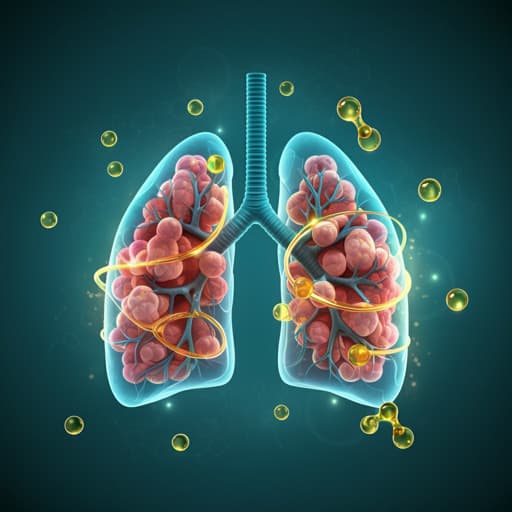
Medicine and Health
Omega-3 polyunsaturated fatty acids ameliorate PM2.5 exposure induced lung injury in mice through remodeling the gut microbiota and modulating the lung metabolism
J. Li, Y. Chen, et al.
This exciting study conducted by Jingli Li, Yang Chen, Qiangqiang Shi, Jian Sun, Chunyi Zhang, and Lingjing Liu reveals how omega-3 polyunsaturated fatty acid supplementation has the potential to reduce lung injury, inflammation, and oxidative stress in mice exposed to PM2.5. The findings suggest a promising avenue for mitigating the effects of environmental pollutants on lung health.
~3 min • Beginner • English
Introduction
Fine particulate matter (PM2.5) is a major global air pollutant and a growing public health threat. PM2.5 can reach distal airways and alveoli and is associated with increased risk of COPD, asthma, and lung cancer. Inflammatory responses and oxidative stress are considered key mechanisms in PM2.5-induced lung injury. Omega-3 PUFAs (notably EPA and DHA) possess anti-inflammatory, antioxidant, and immunomodulatory properties, and have been shown to alleviate PM2.5-induced lung injury in some settings, though mechanisms remain unclear. The gut microbiota, shaped by environment and diet, impacts host immunity and disease. PM2.5 exposure can alter gut microbiota; ω-3 PUFAs can also remodel it. Given the bidirectional gut–lung axis, dietary modulation of gut microbiota may influence lung inflammation. This study hypothesized that ω-3 PUFAs supplementation protects against PM2.5-induced lung injury by impacting gut microbiota and lung metabolome. The primary goal was to assess ω-3 PUFAs’ effectiveness against PM2.5-induced lung injury in mice; the secondary goal was to characterize changes in gut microbiome (16S rRNA sequencing) and lung metabolome (untargeted LC-MS), to elucidate potential mechanisms and therapeutic strategies.
Literature Review
Epidemiology links PM2.5 exposure with higher incidences of COPD, asthma, and lung cancer. Mechanistic studies implicate oxidative stress and inflammatory cytokine cascades as core drivers of PM2.5 lung toxicity. ω-3 PUFAs (EPA/DHA) from fish oil have documented anti-inflammatory and antioxidant effects across disorders, including respiratory diseases, and parenteral or dietary ω-3 PUFAs have been reported to alleviate lung injury in models of PM2.5 exposure. Environmental exposures and diet shape the gut microbiota; PM2.5 can perturb gut microbial composition and function, and ω-3 PUFAs can remodel the gut microbiota, sometimes increasing SCFA-producing taxa and reducing inflammation. The gut–lung axis provides a framework whereby gut dysbiosis can modulate lung immune tone and inflammation, while lung inflammation can feed back to the gut. Prior work suggests arachidonic acid metabolism and related eicosanoid pathways are important in pollutant-induced inflammation and may be modulated by ω-3 PUFAs. However, integrated analyses of how ω-3 PUFAs reshape both gut microbiota and lung metabolome in PM2.5-induced lung injury have been limited.
Methodology
Design: Male C57BL/6N mice were acclimated for 1 week and then randomized into four groups (n = 15/group): Control (standard diet), PM2.5 (standard diet + PM2.5), ω-3 PUFAs (ω-3 diet), and ω-3 PUFAs + PM2.5 (ω-3 diet + PM2.5). Diets: Standard AIN-93G vs ω-3 PUFA–enriched diet differing only in oil source; ω-3 diet contained fish oil (EPA:DHA ≈ 3:2) at 70 g/kg diet (ω-3 PUFAs 21 g/kg), replacing soybean oil. Diets were stored at −20 °C under nitrogen and provided fresh daily for 6 weeks; body weight and intake were monitored (no differences observed). PM2.5 exposure: During weeks 5–6, mice received intratracheal instillations of PM2.5 (SRM 1649b Urban Dust; 5.4 mg/kg in PBS; sonicated 10 min) or PBS on days 1, 5, 9, and 13. Sample collection: 24 h after the final instillation, mice were sacrificed. BALF was collected (6 mL PBS lavage; ~80% recovery), centrifuged; supernatant stored for cytokines. Serum was obtained by centrifugation. Lungs were harvested; portions fixed in 4% formaldehyde for histology; remaining tissues and sera stored at −80 °C. Colon contents (~0.5 g) were snap-frozen for microbiome analysis. Histology: Formalin-fixed, paraffin-embedded lungs sectioned (5 μm), stained with H&E, and examined for morphology and inflammation. Inflammation assays: TNF-α, IL-1β, IL-6, IL-17 measured in BALF and serum by ELISA (Nanjing Jiancheng). Oxidative stress assays: ROS and MDA quantified; antioxidant GSH and T-SOD measured in BALF and serum (commercial kits, Nanjing Jiancheng). Lung metabolomics: Lung homogenates extracted with methanol/water and ethyl acetate/methanol, combined, dried, reconstituted, and analyzed by UPLC-QTOF-MS (Agilent 1290/6545) in positive and negative ESI modes. Chromatography on Waters ACQUITY UPLC HSS T3 C18 (2.1×100 mm, 1.8 μm) with water/acetonitrile (0.1% formic acid) gradient at 0.4 mL/min. Raw files converted to mzML (ProteoWizard); metabolites identified via in-house database and public databases including metDNA. Statistics performed in R: univariate (t-test, ANOVA) and multivariate (PCA, OPLS-DA). Pathway enrichment via KEGG and MetaboAnalyst 5.0. Microbiome (16S rRNA gene) sequencing: DNA extracted from colonic contents (QIAamp DNA Stool Mini Kit). Sequencing on Illumina NovaSeq. Processing with FLASH, QIIME, UCHIME, Uparse; OTU clustering at 97% similarity; taxonomy assigned with Silva V123. Diversity analyses: alpha (Chao1, ACE, Shannon, Simpson) and beta (weighted UniFrac PCoA, clustering). LEfSe used to identify differentially abundant taxa (LDA thresholds specified). Statistics: Data as mean ± SD; normality assessed; unpaired t-tests for two-group comparisons; two-way ANOVA with Tukey’s post hoc for ≥3 groups; Spearman correlations for lung metabolome–fecal microbiome associations; significance at p < 0.05.
Key Findings
- Body weight: No significant differences across groups at baseline or study end; diets and PM2.5 exposure did not affect weight.
- Histopathology: PM2.5 caused black particle deposition, neutrophil infiltration, and alveolar wall thickening. ω-3 PUFAs + PM2.5 showed milder damage with more intact alveolar structures versus PM2.5 alone.
- Inflammation (BALF and serum): PM2.5 significantly increased TNF-α, IL-1β, IL-6, IL-17 (p < 0.05). ω-3 PUFAs supplementation mitigated these increases; no significant differences between control and ω-3 alone.
- Oxidative stress (BALF and serum): PM2.5 elevated ROS and MDA (p < 0.05) and reduced GSH and T-SOD (p < 0.05). ω-3 PUFAs supplementation decreased ROS and MDA and increased GSH and T-SOD versus PM2.5 (p < 0.05), indicating alleviated oxidative stress.
- Lung metabolome: PCA showed separation among groups (PC1 20.69%, PC2 13.47%), indicating both PM2.5 and ω-3 diets altered lung metabolic profiles. OPLS-DA: clear separations with strong model performance: control vs PM2.5 (R2X = 0.327, R2Y = 0.994, Q2 = 0.808); PM2.5 vs ω-3 + PM2.5 (R2X = 0.442, R2Y = 0.998, Q2 = 0.826). Differential metabolites: control vs PM2.5—42 upregulated and 14 downregulated (fold change ≥2 or ≤0.5; p < 0.05). PM2.5 vs ω-3 + PM2.5—71 upregulated and 126 downregulated (197 total); 16 metabolites overlapped between comparisons. Pathway enrichment of metabolites altered by ω-3 PUFAs highlighted VEGF signaling, asthma, arachidonic acid metabolism, and alpha-linolenic acid metabolism.
- Gut microbiota diversity and composition: Rarefaction indicated adequate sequencing depth. Weighted UniFrac PCoA showed no marked global separation among the four groups. Alpha-diversity (Chao1, ACE, Shannon, Simpson) significantly decreased in PM2.5 vs control (p < 0.05 or p < 0.01). ω-3 PUFAs + PM2.5 showed a non-significant tendency toward increased diversity vs PM2.5. At the phylum level, Firmicutes and Bacteroidota dominated (~80%). PM2.5 increased Firmicutes and Bacteroidota and decreased Verrucomicrobiota, Proteobacteria, Actinobacteriota, Acidobacteriota; ω-3 PUFAs attenuated these changes. LEfSe identified distinct taxa: control enriched in Proteobacteria (including Alphaproteobacteria, Gammaproteobacteria); PM2.5 enriched in Bacilli, Firmicutes, Erysipelotrichales/Erysipelotrichaceae; ω-3 + PM2.5 associated with taxa such as unidentified Christensenellaceae and Christensenella sp. Marseille P2437. Between control and PM2.5, 50 taxa differed; between PM2.5 and ω-3 + PM2.5, four taxa differed (PM2.5: Firmicutes; ω-3 + PM2.5: Clostridium_methylpentosum_group, Streptosporangiaceae, Nonomuraea).
- Microbiome–metabolome correlations: Verrucomicrobiota positively correlated with PC(18:1(9Z)/18:4(6Z,9Z,12Z,15Z)) (r = 0.80, p < 0.01), 1-Octadecyl-2-acetyl-sn-glycero-3-phosphocholine (r = 0.65, p < 0.05), DG(22:0/22:6/0:0) (r = 0.64, p < 0.05), Janthitrem C (r = 0.64, p < 0.05), and negatively correlated with N-(Carboxymethyl)-D-alanine (r = −0.91, p < 0.01), Prostaglandin G2 (r = −0.85, p < 0.01), Trp Pro Asp (r = −0.85, p < 0.01), 13(S)-HpOTrE (r = −0.81, p < 0.01), Prostaglandin C2 (r = −0.80, p < 0.01). These associations suggest interactions between ω-3 PUFAs–modulated microbes and lung metabolites.
Discussion
The study demonstrates that dietary ω-3 PUFAs protect against PM2.5-induced lung injury by dampening inflammatory cytokine responses and oxidative stress, aligning with recognized mechanisms of PM-induced toxicity. ω-3 PUFAs likely exert effects through antioxidant and anti-inflammatory pathways, potentially including suppression of ROS and modulation of NLRP3 inflammasome activation. Lung metabolomics revealed broad remodeling with ω-3 PUFAs, notably implicating arachidonic acid and alpha-linolenic acid metabolism, VEGF signaling, and asthma-related pathways—consistent with EPA/DHA competing with arachidonic acid for cyclooxygenase/5-lipoxygenase and reducing pro-inflammatory eicosanoids. Gut microbiota analyses showed PM2.5-induced dysbiosis (reduced alpha-diversity and compositional shifts) that was attenuated by ω-3 PUFAs, including enrichment of taxa associated with beneficial metabolites (e.g., SCFA producers). Correlative analyses linked specific microbial phyla (e.g., Verrucomicrobiota) with differential lung metabolites, supporting a gut–lung axis mechanism whereby dietary ω-3 PUFAs modulate gut ecology to influence pulmonary metabolic and immune states. Collectively, these findings address the hypothesis that ω-3 PUFAs ameliorate PM2.5 lung injury via coordinated effects on gut microbiota and lung metabolism, underscoring translational potential for dietary interventions in pollution-related respiratory injury.
Conclusion
Supplementary ω-3 PUFAs attenuated PM2.5-induced lung injury in mice, demonstrating preventive and therapeutic potential. Protection was associated with reduced inflammation and oxidative stress, restoration of lung metabolic profiles, and attenuation of gut dysbiosis. These results enhance understanding of PM2.5-induced lung injury and support ω-3 PUFAs as a potential therapeutic strategy.
Limitations
- The study did not assess potential antioxidant/anti-inflammatory effects of soybean polyphenols or identify specific PM2.5 components responsible for observed effects.
- PM2.5 exposure via intratracheal instillation differs from inhalation in toxicokinetics/dynamics; inhalation would better model human exposure.
- Microbiome analysis used 16S rRNA sequencing; shotgun metagenomics could provide higher-resolution taxonomic and functional insights.
- Pathway enrichment analyses were exploratory and did not account for effect directionality.
- Correlations between key microbiota and differential metabolites require further validation to establish causality and mechanisms.
Related Publications
Explore these studies to deepen your understanding of the subject.







